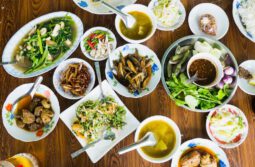Myanmar Food Culture
Tips for Dining in Myanmar When eating food in street stalls and markets, void eating doubtful meat and try vegetables instead. Although usual Asian flavors dominate Myanmar, in recent years, Yangon and Bagan have seen a spring in international restaurants, such as western, Japanese, Chinese and even Korean. The Chinatown located at the downtown Yangon […]
Tips for Dining in Myanmar
- When eating food in street stalls and markets, void eating doubtful meat and try vegetables instead.
- Although usual Asian flavors dominate Myanmar, in recent years, Yangon and Bagan have seen a spring in international restaurants, such as western, Japanese, Chinese and even Korean.
- The Chinatown located at the downtown Yangon is a good place to find various kinds of foods from all over Asia.
- The concept of service is in its infancy, so don’t expect western standards in dining place. While upmarket restaurants do better.
- Tipping is not common practice in Myanmar, but it’s appreciated. A 5-10% tip will do.
- Staff working at western cafes/restaurants can speak English, but not those in the markets or street stands. If the language doesn’t work, keep patient and turn to your private tour guidefor help (if out of the itinerary).
- Never drink tap water, use bottled drinking water which is available at every shop. Or our guide will help you with this.
- There are no sophisticated social rules for dining in Myanmar. Watch what the locals do and follow suit.

General Introduction of Myanmar Food
The food of Myanmar is a fusion of Southeastern, Chinese and Indian cuisines. It has an emphasis on rich savory and a bunch of ingredients that are rarely seen in any other food cultures. The variety of Myanmar food is impacted by its diverse geographical features, preferable weather, fertile land and sufficient water resources.
Having rice as staple food, Myanmar people consume it 75% of the diet. They also rely on seafood a lot, making fish sauce an important ingredient for each meal. Pork and beef are avoided by Buddhists who deem cattle as a sacred animal while pigs a filthy. Chicken is a favorable meat that used widely, especially popular with Muslims. Fresh greens and fruits are common garnishments, some of which are made into salads to complement the meal. There is one condiment that cannot be ignored – a relish made from prawn or fish seasoned with chili powder.
The food in Myanmar could be oily and less spicy as that in its neighbor Thailand, but it’s for sure you’ll return from Myanmar with a satisfied stomach.




